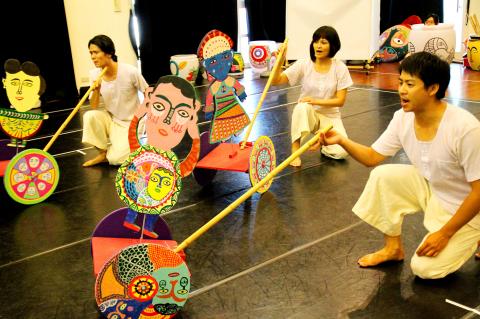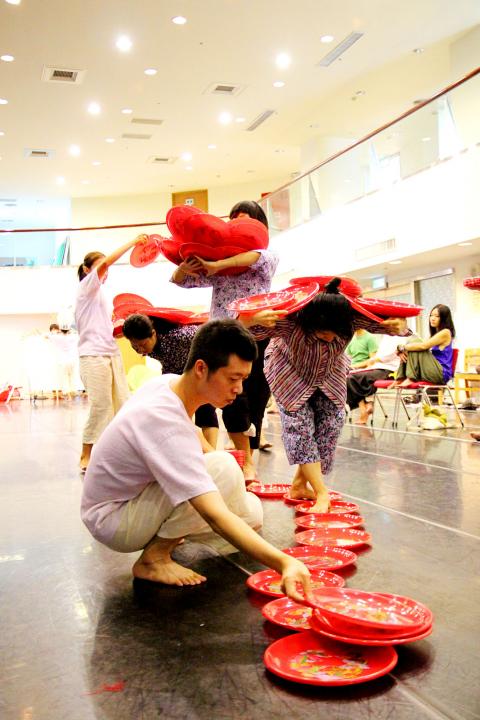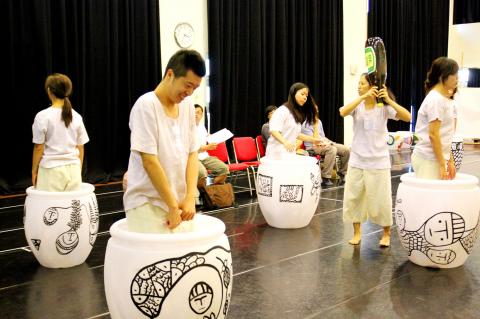The life of artist Hung Tung (洪通) is the stuff of legend. Orphaned at the age of four, he was illiterate and spent most of his life earning a meager living by working odd jobs. He started to paint at 50, was quickly discovered by the media, and rocketed to fame in the 1970s. Some hailed him as a genius; others said he was a lunatic. Forty years later, many people don’t even know his name.
The Puppet & Its Double Theater (無獨有偶工作室劇團) is reviving the eccentric painter’s story with Who’s Hung Tung (洪通計劃), a theatrical production commissioned by the Taipei Arts Festival (台北藝術節) that pays tribute to Hung and renowned musician Lee Tai-hsiang (李泰祥).
To learn about the artist firsthand, actors, theater designers and other members of the troupe visited Hung’s old home in today’s Kunjiang Village (鯤江村), Greater Tainan, to conduct research and interview his relatives, friends and neighbors. Company director Cheng Chia-yin (鄭嘉音) says that what they learned about Hung didn’t set the story straight.

Photo courtesy of The Puppet & Its Double Theater
Some say the artist once worked at Taoist temples as a spirit medium, or dangki as they are known in Hoklo (commonly known as Taiwanese), and was possessed by deities when he painted. Others claim Hung used his own penis as a painting tool. The painter was often spotted practicing the monkey fist (猴拳), a martial arts move, or singing Taiwanese operas in the middle of crop fields, but he was mostly perceived as a loner who escaped fame by locking himself in his hut. He died in 1987.
“Different people say different things, so we find it very difficult to present Hung with a single, linear story,” Cheng told the Taipei Times. “We chose to approach him from various angles and incorporate multiple perspectives.”
As a result, Who’s Hung Tung is more of a creative search for the artist than a straight biography. Composed of 15 segments, the 80-minute performance contains recurrent themes, images and characters such as Bird-Man, who Cheng says was inspired by Hung’s wish to become a bird. There are sections that depict anecdotes about the painter or revisit different opinions about his folk-themed work. The strange creatures, human heads, and fauna and flora on Hung’s rich canvases are transferred to the stage as puppets, figures and masks that the performers use to convey their reflections on the painter and his art.

Photo courtesy of The Puppet & Its Double Theater
The vignette-like structure also reflects the way the work was collectively developed by all of the participating artists, Cheng says. For example, the actors spent days playing with objects and materials to explore their potential as props. Items commonly found at temple fairs, such as bamboo and offering plates, feature prominently because Taoist mysticism is believed to have had a strong influence on Hung’s aesthetic vocabulary.
“We visited the temple near Hung’s old home,” Cheng says. “When Taoist rituals take place it fills with incense smoke and the deafening sound of gongs and drums. It’s a lot like his paintings, which overflow with excessiveness and abundance.”
The production is in Mandarin and Hoklo, with English programs available at the door.

Photo courtesy of The Puppet & Its Double Theater
Comments:
Letter to the editor:
Your story today about artist Hung Tung said that he started to paint at the age of 50 and was "quickly discovered by the media and rocketed to fame in the 1970s." As I recall it, he labored in obscurity for some time and only came to media attention after the U.S. Information Service gave him a one-man show. Many in the art establishment were shocked that such a primitive artist (he was often compared to "Grandma Moses" in the U.S.) could receive such recognition. After gaining fame, the eccentric Hung agreed only reluctantly to offer any of his works for sale.
Don Shapiro

April 14 to April 20 In March 1947, Sising Katadrepan urged the government to drop the “high mountain people” (高山族) designation for Indigenous Taiwanese and refer to them as “Taiwan people” (台灣族). He considered the term derogatory, arguing that it made them sound like animals. The Taiwan Provincial Government agreed to stop using the term, stating that Indigenous Taiwanese suffered all sorts of discrimination and oppression under the Japanese and were forced to live in the mountains as outsiders to society. Now, under the new regime, they would be seen as equals, thus they should be henceforth

Last week, the the National Immigration Agency (NIA) told the legislature that more than 10,000 naturalized Taiwanese citizens from the People’s Republic of China (PRC) risked having their citizenship revoked if they failed to provide proof that they had renounced their Chinese household registration within the next three months. Renunciation is required under the Act Governing Relations Between the People of the Taiwan Area and the Mainland Area (臺灣地區與大陸地區人民關係條例), as amended in 2004, though it was only a legal requirement after 2000. Prior to that, it had been only an administrative requirement since the Nationality Act (國籍法) was established in

With over 80 works on display, this is Louise Bourgeois’ first solo show in Taiwan. Visitors are invited to traverse her world of love and hate, vengeance and acceptance, trauma and reconciliation. Dominating the entrance, the nine-foot-tall Crouching Spider (2003) greets visitors. The creature looms behind the glass facade, symbolic protector and gatekeeper to the intimate journey ahead. Bourgeois, best known for her giant spider sculptures, is one of the most influential artist of the twentieth century. Blending vulnerability and defiance through themes of sexuality, trauma and identity, her work reshaped the landscape of contemporary art with fearless honesty. “People are influenced by

The remains of this Japanese-era trail designed to protect the camphor industry make for a scenic day-hike, a fascinating overnight hike or a challenging multi-day adventure Maolin District (茂林) in Kaohsiung is well known for beautiful roadside scenery, waterfalls, the annual butterfly migration and indigenous culture. A lesser known but worthwhile destination here lies along the very top of the valley: the Liugui Security Path (六龜警備道). This relic of the Japanese era once isolated the Maolin valley from the outside world but now serves to draw tourists in. The path originally ran for about 50km, but not all of this trail is still easily walkable. The nicest section for a simple day hike is the heavily trafficked southern section above Maolin and Wanshan (萬山) villages. Remains of